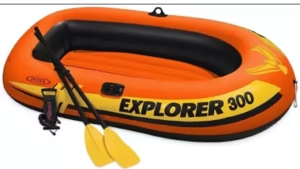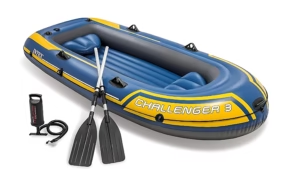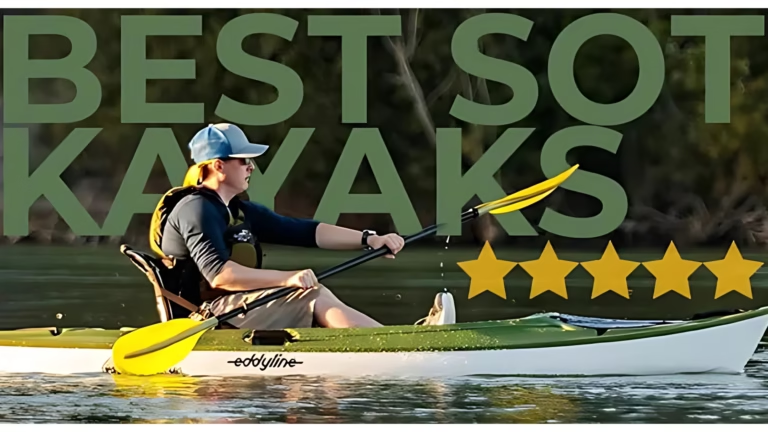The best inflatable kayaks for beginners are the Intex Explorer K2 and the Sea Eagle 330. Both are user-friendly and durable.
Starting kayaking can be an exciting adventure for beginners. Inflatable kayaks are a great choice due to their portability and ease of use. The Intex Explorer K2 is perfect for calm waters and provides excellent stability. The Sea Eagle 330 is versatile, handling both flat and white waters.
These kayaks are lightweight, easy to inflate, and offer great value for money. They also come with essential accessories, making your kayaking experience more enjoyable. Whether you plan a weekend outing or a leisurely paddle, these kayaks ensure a safe and fun experience for beginners.
Introduction To Inflatable Kayaks
Inflatable kayaks have become very popular among beginners. They offer a flexible and easy way to enjoy kayaking without the hassle of heavy equipment.
These kayaks are versatile and easy to transport. They are perfect for people who do not have much storage space. Let’s dive into why inflatable kayaks are a great choice for beginners.

Why Choose An Inflatable Kayak?
Choosing an inflatable kayak has many advantages. First, they are lightweight and easy to carry. You do not need a large vehicle to transport them. They can fit in the trunk of a car.
Inflatable kayaks are also very affordable. Traditional kayaks can be expensive, but inflatable ones are budget-friendly. This makes them perfect for people new to kayaking.
Lastly, they are very durable. Modern inflatable kayaks are made from strong materials. They can withstand bumps and scrapes without getting damaged.
Benefits For Beginners
Inflatable kayaks are ideal for beginners due to their ease of use. They are easy to set up and require no special skills. A beginner can inflate and deflate them quickly.
They are also very stable on the water. This stability helps beginners feel safe and confident. Falling out is less likely compared to traditional kayaks.
Additionally, they provide a comfortable experience. Most inflatable kayaks come with padded seats. This makes long paddling sessions more enjoyable.
Key Features To Look For
Choosing the best inflatable kayak for beginners can be a tough task. To help you make an informed decision, let’s explore the key features to consider. These features will ensure you pick the right kayak that suits your needs. We’ll dive into aspects like material, durability, weight, portability, and inflation time.
Material And Durability
The material of an inflatable kayak is crucial for its performance and longevity. Look for kayaks made of PVC, Hypalon, or Nitrylon. These materials are resistant to punctures and abrasions.
- PVC: Lightweight and affordable, but less durable.
- Hypalon: Extremely durable and resistant to UV rays.
- Nitrylon: Eco-friendly and highly durable.
A durable kayak will withstand rough waters and last longer. Ensure the kayak has multiple air chambers. This feature adds safety in case one chamber deflates.
Weight And Portability
Portability is a key advantage of inflatable kayaks. They are easy to transport and store. Check the weight of the kayak before purchasing. Most kayaks weigh between 20 to 40 pounds.
| Kayak Type | Average Weight |
|---|---|
| Single-Person Kayak | 20-30 pounds |
| Tandem Kayak | 30-40 pounds |
A lighter kayak is easier to carry and handle. Ensure it comes with a carry bag for added convenience.
Inflation And Deflation Time
Quick inflation and deflation times are essential for a hassle-free experience. Look for kayaks with high-quality valves like Boston valves or Halkey-Roberts valves. These valves make inflating and deflating quick and easy.
- Boston Valves: Simple to use, allows fast inflation and deflation.
- Halkey-Roberts Valves: High-pressure capable, ensures quick setup.
Most inflatable kayaks inflate within 5 to 10 minutes. A fast setup means more time on the water and less time prepping.
Top Picks For Beginners
Finding the best inflatable kayak can be daunting for beginners. The right kayak should be stable, durable, and easy to use. Here are our top picks for beginners that meet these criteria.
Best Overall Inflatable Kayak
The Intex Explorer K2 stands out as the best overall inflatable kayak for beginners. Its features include:
- Stability: The kayak has a low-profile design for better balance.
- Durability: Made from heavy-duty vinyl for long-lasting use.
- Comfort: Adjustable inflatable seats with backrests.
- Ease of Use: Comes with a high-output air pump for quick inflation.
Best Budget-friendly Option
The Intex Challenger K1 is a perfect choice for those on a budget. Key features include:
- Affordable: Great value for the money.
- Compact: Lightweight and easy to carry.
- Safety: Bright graphics for better visibility.
- Convenience: Includes a cargo net for extra storage.
Best For Solo Paddlers
For solo paddlers, the Advanced Elements AdvancedFrame is an excellent option. Its highlights are:
- Performance: Built-in aluminum ribs improve tracking.
- Comfort: Padded seat and adjustable back support.
- Portability: Folds easily for transport and storage.
- Durability: Multi-layer construction for added strength.
Best For Tandem Paddling
The Sea Eagle 370 is ideal for tandem paddling. Its top features include:
- Capacity: Can hold up to three people.
- Versatility: Suitable for both calm waters and mild rivers.
- Durability: Made from heavy-duty PVC material.
- Convenience: Comes with two paddles and a foot pump.
Safety Tips For First-time Kayakers
Kayaking is an exciting adventure, especially for beginners. Ensuring safety is crucial for a fun experience. Let’s explore some essential safety tips to keep first-time kayakers safe on the water.
Essential Safety Gear
Having the right safety gear is vital. Here are some must-have items:
- Life Jacket: Always wear a life jacket. It keeps you afloat.
- Helmet: Protect your head with a helmet. It’s crucial in rough waters.
- Whistle: A whistle helps you signal for help. Attach it to your life jacket.
- First Aid Kit: Carry a basic first aid kit. It helps in minor injuries.
- Dry Bag: Use a dry bag for your phone and valuables. It keeps them safe and dry.
Basic Paddling Techniques
Learning basic paddling techniques enhances safety and enjoyment. Follow these steps:
- Grip the Paddle Correctly: Hold the paddle with both hands, shoulder-width apart.
- Forward Stroke: Dip the paddle blade into the water near your feet. Pull it back to your hip.
- Reverse Stroke: Do the opposite of the forward stroke. This helps you go backward.
- Sweep Stroke: Sweep the paddle in a wide arc. This helps you turn the kayak.
- Brace Stroke: Use this stroke to regain balance. Push the paddle against the water.
These tips and techniques will ensure a safe and enjoyable kayaking experience. Always be prepared and stay alert on the water.
Maintenance And Care
Inflatable kayaks are perfect for beginners. They are portable and easy to use. Proper maintenance and care ensure your kayak lasts long. Below are tips for keeping your kayak in top shape.
Cleaning And Storage
Clean your kayak after each use. Rinse with fresh water. This removes salt, dirt, and debris. Use a mild soap for tough stains. Avoid harsh chemicals. Dry the kayak completely. This prevents mold and mildew.
Store your kayak in a cool, dry place. Avoid direct sunlight. UV rays can damage the material. Deflate the kayak partially. This prevents stress on seams. Use a storage bag if available.
Repair And Patching
Small punctures can happen. Always carry a repair kit. To fix a leak, clean the area first. Use the patch from the kit. Apply adhesive and press firmly. Let it dry for several hours.
For larger tears, use a professional repair service. Inspect your kayak regularly. Look for signs of wear and tear. Early detection prevents bigger problems.
| Maintenance Task | Frequency | Tips |
|---|---|---|
| Cleaning | After each use | Rinse with fresh water |
| Drying | After each use | Ensure kayak is completely dry |
| Storage | Ongoing | Store in a cool, dry place |
| Inspection | Monthly | Check for wear and tear |
| Repair | As needed | Carry a repair kit |
- Clean your kayak after every use.
- Dry it thoroughly to prevent mold.
- Store it in a cool, dry place away from sunlight.
- Inspect regularly for damage.
- Repair small punctures immediately.
Pros And Cons
Choosing the best inflatable kayak for beginners can be challenging. It’s essential to weigh the pros and cons before making a decision. This section will explore the advantages and potential drawbacks of inflatable kayaks.
Advantages Of Inflatable Kayaks
Inflatable kayaks offer several benefits, especially for beginners. Here are some key advantages:
- Portability: These kayaks are easy to carry. You can pack them in a backpack.
- Storage: They take up less space. Store them in small apartments.
- Affordability: Inflatable kayaks are often cheaper. They suit budget-friendly buyers.
- Ease of Use: Beginners find them easy to handle. They are also lightweight.
- Durability: Modern materials ensure they last long. They can resist punctures.
Potential Drawbacks
While inflatable kayaks have many pros, there are some cons. Here are a few potential drawbacks:
- Setup Time: Inflating takes a few minutes. Beginners might find this tedious.
- Performance: They may not perform like hard-shell kayaks. They are slower in water.
- Stability: Some models may lack stability. They can tip over in rough waters.
- Durability: Despite improvements, they are still prone to punctures. Sharp objects can damage them.
- Maintenance: Proper care is essential. Dry them thoroughly to prevent mold.
Understanding these pros and cons helps in making an informed choice. Inflatable kayaks can be a great start for beginners.
Final Thoughts
Choosing the best inflatable kayak for beginners can be challenging. There are many factors to consider. We hope this guide helps you make an informed decision.
Making The Right Choice
Here are some tips to help you choose the right kayak:
- Material: Look for durable materials like PVC or Hypalon.
- Size: Consider the kayak’s length and width.
- Weight Capacity: Ensure it can support your weight and gear.
- Stability: Beginners need a stable kayak for balance.
- Accessories: Check if it comes with essential accessories.
Getting Started On The Water
Once you have your kayak, here are steps to get started:
- Inflate: Use a pump to inflate your kayak.
- Check: Ensure all parts are securely attached.
- Wear: Put on a life jacket for safety.
- Launch: Find a calm spot to launch your kayak.
- Paddle: Use smooth strokes to move forward.
| Feature | Importance |
|---|---|
| Material | High |
| Size | Medium |
| Weight Capacity | High |
| Stability | High |
| Accessories | Medium |
With the right kayak and safety measures, you’ll have fun. Happy kayaking!
Frequently Asked Questions
What Is The Best Inflatable Kayak For Beginners?
The Intex Explorer K2 is a top choice for beginners. It’s affordable, stable, and easy to maneuver. Plus, it comes with essential accessories.
Are Inflatable Kayaks Safe For Beginners?
Yes, inflatable kayaks are safe for beginners. They are designed for stability and durability. Always follow safety guidelines and use life vests.
How Do I Inflate An Inflatable Kayak?
Use an air pump to inflate your kayak. Most inflatable kayaks come with a manual or electric pump. It usually takes about 10 minutes.
What Materials Are Inflatable Kayaks Made Of?
Inflatable kayaks are typically made of PVC, nylon, or Hypalon. These materials are durable, puncture-resistant, and lightweight, making them ideal for beginners.
Conclusion
Choosing the right inflatable kayak can enhance your paddling experience. Beginners should prioritize stability, durability, and ease of use. This guide has highlighted top choices to help you start your kayaking journey. Happy paddling with your new inflatable kayak!





